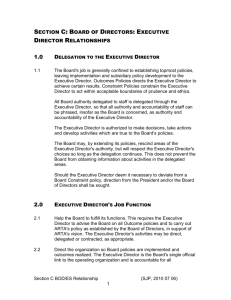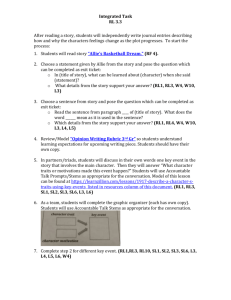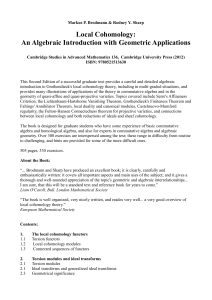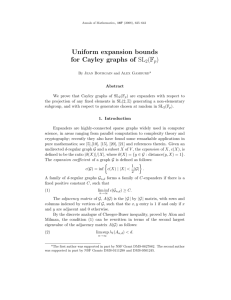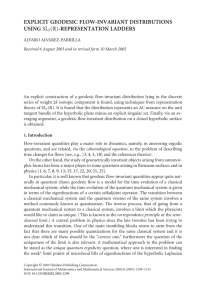The basic objects in the cohomology theory of arithmetic groups
advertisement
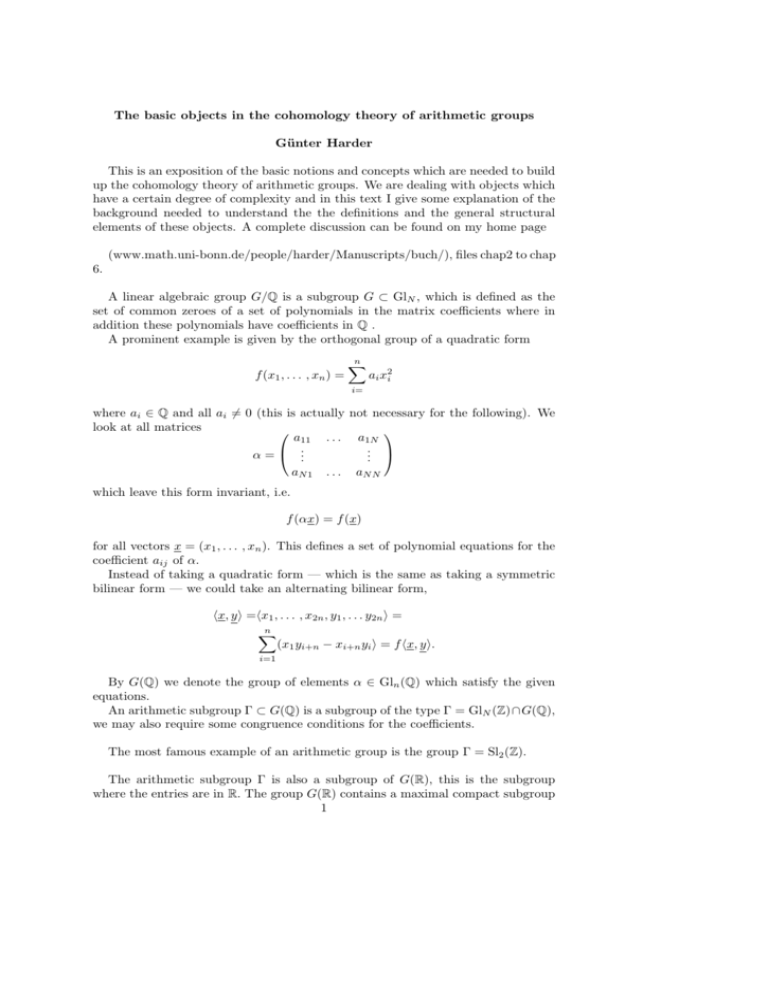
The basic objects in the cohomology theory of arithmetic groups
Günter Harder
This is an exposition of the basic notions and concepts which are needed to build
up the cohomology theory of arithmetic groups. We are dealing with objects which
have a certain degree of complexity and in this text I give some explanation of the
background needed to understand the the definitions and the general structural
elements of these objects. A complete discussion can be found on my home page
(www.math.uni-bonn.de/people/harder/Manuscripts/buch/), files chap2 to chap
6.
A linear algebraic group G/Q is a subgroup G ⊂ GlN , which is defined as the
set of common zeroes of a set of polynomials in the matrix coefficients where in
addition these polynomials have coefficients in Q .
A prominent example is given by the orthogonal group of a quadratic form
f (x1 , . . . , xn ) =
n
X
ai x2i
i=
where ai ∈ Q and all ai 6= 0 (this is actually not necessary for the following). We
look at all matrices
a11 . . . a1N
.
.
..
α = ..
aN 1 . . . aN N
which leave this form invariant, i.e.
f (αx) = f (x)
for all vectors x = (x1 , . . . , xn ). This defines a set of polynomial equations for the
coefficient aij of α.
Instead of taking a quadratic form — which is the same as taking a symmetric
bilinear form — we could take an alternating bilinear form,
hx, yi =hx1 , . . . , x2n , y1 , . . . y2n i =
n
X
(x1 yi+n − xi+n yi i = f hx, yi.
i=1
By G(Q) we denote the group of elements α ∈ Gln (Q) which satisfy the given
equations.
An arithmetic subgroup Γ ⊂ G(Q) is a subgroup of the type Γ = GlN (Z)∩G(Q),
we may also require some congruence conditions for the coefficients.
The most famous example of an arithmetic group is the group Γ = Sl2 (Z).
The arithmetic subgroup Γ is also a subgroup of G(R), this is the subgroup
where the entries are in R. The group G(R) contains a maximal compact subgroup
1
K∞ ⊂ G(R) we can form the quotient space X = G(R)/K∞ , if G/Q is semisimple then X carries a Riemannian metric with negative curvature an its connected
components are diffeomorphic to some Rd . The group Γ acts on X from the left,
this action is properly discontinuous, this means that for any point x ∈ X there
exist a neighborhood Ux such that for any γ ∈ Γ we have γ(Ux ) ∩ Ux = ∅ or γ is in
the stabilizer Γx = {γ|γx = x}, this stabilizer is always finite. It can happen that
the group ZΓ of elements which act trivially on X is non trivial, i.e.
ΓZ = {γ|γ ∈ Γ, γx = x for all x ∈ X} =
6 {e}.
Then it is sometimes useful to replace Γ by Γ/ΓZ . A point x ∈ X is called a fixed
point if Γx 6= ΓZ .
Starting from the data Γ, X we form the quotient spaces Γ\X, these are so
called locally symmetric spaces. We consider the projection π : X → Γ\X. A point
x̄ ∈ Γ\X is called a fixed point if the points x ∈ π −1 (x̄) are fixed points.
If our arithmetic group is Sl2 (Z) then the symmetric space is the upper half
plane H = {z ∈ C|=(z) > 0}, we have the classical fundamental domain ) in the
upper half plane (first picture) and after the necessary identifications the resulting
quotient space is given by the second picture.
1 1
(The two vertical lines are identified because T =
∈ Sl2 (Z) and T acts
0 1
0 1
by z 7→ z + 1, and on the bottom arc the matrix S
∈ Sl2 (Z) induces the
−1 0
reflection at the imaginary axis.)
.
.
....................................................................................................................................
..
..
..
...
...
...
.
..
..
....................................
.
.
.
.
.
.
.
.
.
.
.
.
.
...
.
.
.......
.......
.
..
..
...
...
...
..
..
..
...
...
...
..
..
..
...
...
...
.
..............................................................
−1
− 12
0
2
1
2
1
................................................
..............................
.......
...........
.....
.....................
.
.
.
.
.
.
.
.
.................................................... ..
................................................
..............................
.......
...........
.....
.....................
.
.
.
.
.
.
.
.
.................................................... ..
................................................
..............................
.
............................................... ..................................................
..................... ................. ........................
........................... ........................................
...........
..........
......
But we need more ingredients, we also consider Γ− modules M, especially we
are interested in Γ modules which come from rational representations of the given
algebraic group G/Q. If for instance our group is Sl2 then a nice Γ− module is the
free Z-module of homogenous polynomials of degree n in two variables X, Y with
coefficients in Z
ν=n
X
Mn = {
aν X ν Y n−ν |aν ∈ Z}
ν=0
Such a Γ modules provides a sheaf of abelian groups M̃ on Γ\X. By definition
a sheaf on Γ\X with values in the sheaf of abelian of abelian groups is a rule that
3
attaches to any open subset V ⊂ Γ\X an abelian group M̃ where this rule satisfies
certain compatibilities with respect to restriction to smaller sets. In our case we
define
M̃(V ) = {f : π −1 : V → M|f is locally constant, f (γu) = γf (u)}.
For any such such sheaf one can define the sheaf cohomology groups
H q (Γ\X, M̃); q = 0, . . . dim(X)
In general the quotient spaces are not compact, but they have finite volume.
They admit a natural compactification, the so called Borel-Serre compactification
i : Γ\X ,→ Γ\X̄, then ∂(Γ\X̄) is the boundary Γ\X̄ \ Γ\X. The sheaves extend
to this compactification and we have an isomorphism
∼
i• H q (Γ\X, M̃) −→ H q (Γ\X̄, M̃).
We also have the notion of the the cohomology with compact supports Hcq (Γ\X, M̃)
and we get the fundamental long exact sequence
→ H q−1 (∂(Γ\X), M̃) → Hcq (Γ\X, M̃) → H q (Γ\X̄, M̃) → H q (∂(Γ\X), M̃) → . . .
By a theorem of Raghunathan all the cohomology groups are finitely generated
abelian groups provided the module M is a finitely generated abelian group. If M
is a finite dimensional Q vector space the same theorem says that the cohomology
groups are finite dimensional Q vector spaces.
The last ingredient are the Hecke operators. To any α ∈ G(Q) we can define a
collection of endomorphisms
T (α, uα ) : H • (Γ\X, M̃) → H • (Γ\X, M̃),
these endomorphisms also act on the cohomology with compact supports and the
cohomology of the boundary, they are compatible with the long exact sequence.
Main objects of Study: Our main objects of interest are these cohomology
groups as modules under the Hecke algebra H, this is the algebra generated by these
endomorphisms.
I want to say a few words concerning the structure of the Hecke algebra H.
Remember that Γ ⊂ G(Q) was the subgroup in which the matrix coefficients were
integers, the matrix entries of α ∈ G(Q) have denominators. Let us now fix a prime
and consider only α for which the denominator is a power of our given prime p.
Then this yields a subalgebra Hp , the local algebra at p. Then we have the following
a) The Hecke algebras Hp and Hp0 commute if p 6= p0
b) For almost all primes p the Hecke algebra Hp is commutative.
c) In a certain sense we have H =
N
Hp .
4
p
Finally I want to formulate a first fundamental theorem concerning the structure
of the cohomology under the Hecke algebra. We assume that our sheaf M̃ is
obtained from a rational representation of the algebraic group (like in the example
above for Sl2 .) We define the inner cohomology H!q (Γ\X, M̃) as the image
H!q (Γ\X, M̃) = Image(Hcq (Γ\X, M̃) → H q (Γ\X, M̃)),
this are finite dimensional Q vector spaces. Then the theorem says
Theorem:The action of the Hecke algebra H on the inner cohomology H!q (Γ\X, M̃)
is semi simple, i.e. any Hecke-invariant submodule has a complement which is also
Hecke invariant.
The proof of this theorem requires some analysis, we extend the sheaves to
sheaves over the complex numbers, i.e. we replace M which is a sheaf of Q vector
spaces by M ⊗ C. Then we apply Hodge theoretic methods to study H!q (Γ\X, M̃ ⊗
C), this means we apply some functional analysis and the theory of linear elliptic
operators. This allows to introduce a hermtian metric on the cohomology groups
H!q (Γ\X, M̃ ⊗ C) for which the Hecke algebra is self adjoint and then the theorem
follows.
In the classical case that Γ = Sl2 (Z). We construct the Hecke operators but here
we allow that α ∈ Gl2 (Q). Especially we have Hecke operators
p 0
, u
Tp = T
p 0
0 1
0 1
where the second component u
is given by the canonical choice. (Compare
p 0
0 1
chap. II 2.2.1. Then the Hecke-algebra is commutative and Hp = Z[Tp ]. Here we
assume that n is even because for n odd the sheaf is trivial. Then we can apply
our theorem and the commutativity of the Hecke algebra together with the semi
simplicity yield a decomposition into isotypical components
H!1 (Sl2 (Z)\H, M̃n ) = H!1 (Sl2 (Z)\H, M̃n )(Πf ),
where the H!1 (Sl2 (Z)\H, M̃n )(Πf ) are Hecke-invariant sub modules which have the
following property:
a) If I(Πf ) is the annihilator of the submodule H!1 (Sl2 (Z)\H, M̃n )(Πf ), i.e.
I(Πf ) = {T ∈ H|T |H!1 (Sl2 (Z)\H, M̃n )(Πf ) = 0} then H ⊗ Q/I(Πf ) ⊗ Q = K(Πf )
is a field. We denote the map H → H/I(Πf ) also denoted by Πf .
b) Then H!1 (Sl2 (Z)\H, M̃n )(Πf ) is a K(Πf ) vector space and this vector space
is of dimension two.
c) We still have the action of the complex conjugation on the space Sl2 (Z)\H, it
induces an involution c on the cohomology which commutes with the action of the
Hecke algebra. Under this involution the space H!1 (Sl2 (Z)\H, M̃n )(Πf ) decomposes
into two one dimensional K(Πf )− vector spaces
H!1 (Sl2 (Z)\H, M̃n )(Πf ) = H!1 (Sl2 (Z)\H, M̃n )(Πf )c=1 ⊕H!1 (Sl2 (Z)\H, M̃n )(Πf )c=−1
5
The first assertion is rather formal, the second assertion follows from the theory
of automorphic forms. We have to invoke the Eichler-Shimura isomorphism:
If Sn+2 (Sl2 (Z)) is the space of holomorphic cusp forms of weight n + 2 then we
have a canonical Hecke-invariant isomorphism
∼
Φ : Sn+2 (Sl2 (Z)) ⊕ Sn+2 (Sl2 (Z) −→ H!1 (Sl2 (Z))\H, M̃n ⊗ C).
Now the space of cusp forms decomposes into eigenspaces under the action of
the Hecke-algebra: We have a finite number of homomorphisms λ : H → C such
that each such λ yields an eigenspace
Sn+2 (Sl2 (Z))(λ) = {f ∈ Sn+2 (Sl2 (Z))|Tp (f ) = λ(Tp )f }
is of dimension one. This one dimensional space is generated by a normalized cusp
form
fλ (z) = f (z) = q + a2 q 2 + a3 q 3 + a4 q 4 ..... =
∞
X
an q n where q = e2πiz
n=1
and our space of cusp forms is the direct sum of these eigenspaces. For a prime p
we have the equality
ap = λ(Tp ),
the eigenvalues are real. (This is a classical theorem of Hecke.)
Now we get the Eichler-Shimura isomorphism as follows: We pick a Πf . We
consider the set of embeddings Σ = {σ : K(Πf ) → C} it is known that all these
embeddings factor through the field R of real numbers. From any σ : K(Πf ) ,→ C,
then we get a λ by the formula
λ(Tp ) = σ(Πf (Tp )),
and this is just one of the λ which occur in the decomposition of Sn+2 (Sl2 (Z)).
Then for a given Πf the numbers σ(Πf (Tp )) are algebraic integers, they are real
and conjugate under the Galois group of Q̄/Q.
Now we can-again following Hecke- attach an L-function to any such λ = σ ◦ Πf ,
it is defined as the infinite product
Λ(σ ◦ Πf , s) =
1
Γ(s) Y
.
(2π)s p 1 − λ(Tp )p−s + pn+1−2s
Several things are known about this function: First of all we have the deep
theorem of Deligne which says that for all n and all λ we have
|λ(p)| ≤ 2p(n+1)/2 .
This implies that the infinite product converges in the half-plane <(s) > n+1
2 +1
and defines a holomorphic function in this half plane. But we know more
This function has an analytic continuation into the entire complex plane and
satisfies a functional equation
6
Λ(σ ◦ Πf , s) = (−1)n/2+1 Λ((σ ◦ Πf , n + 2 − s).
Finally we have a theorem of Manin and Shimura which says:
We can define two arrays (the periods)
#Σ
Ω = {. . . , Ω±
σ , . . . }σ∈Σ ∈ R
such that for any integer ν with 1 ≤ ν ≤ n + 1 we find a number Λ(Πf , ν) ∈ K(Πf )
such that
σ((Λ(Πf , ν)) =
L(σ ◦ Πf , ν)
(ν)
Ωσ
where (ν) is the parity of ν. If the class number of K(Πf ) is one then we can pin
down the periods up to a pair of units ± ∈ OF× , i.e. we have a procedure of choosing
them such that for any two pairs Ω0,± , Ω± we find a pair of units ± such that
Ω0,± = {. . . , σ(± )Ω±
σ , . . . }σ∈Σ
For 2 ≤ ν ≤ n The numbers Λ(Πf , ν) ∈ K(Πf ) are algebraic integers, if ν = 1
or ν = n then the numbers (1 + pn+1 − Πf (Tp ))Λ(Πf , ν) ∈ K(Πf ) are algebraic
integers.
If the class number is not one then we can find a finite set S of primes which
is disjoint from a given prime p such that the ring R = OF,S has class number
one. Then we can choose our periods in such a way that they are unique up to an
element in R× . Especially we know that the number
ordp (
L(σ ◦ Πf , ν)
(ν)
)
Ωσ
is well defined.
It is a general idea that the arithmetic of these numbers Λ(Πf , ν), i.e. their
decomposition into prime ideals contains some arithmetic information. This hope
is supported by some experiments.
Actually the proof of the theorem of Manin and Shimura is not so difficult. Let
f be the cusp form corresponding to σ. Let us assume for simplicity that our field
K(Πf ) = Q, the we get only one modular form f and its coefficients an ∈ Q.
We have to write down the classical integral representation of the L-function as a
Mellin-transform
Z ∞
dy
Λ(f, s) =
f (iy)y s .
y
0
Via the Eichler-Shimura isomorphism the modular form f and its complex conjugate provide two cohomology classes
ω± = f ± f¯ ∈ H!1 (Sl2 (Z)\H, M̃n ⊗ C)(±),
where we notice that the complex conjugation acts on the cohomology and decomposes it into a plus and a minus eigenspace. We also have this decomposition into
a plus and a minus eigen-module for the integral cohomology
7
H!1 (Sl2 (Z)\H, M̃n ) ⊃ H!1 (Sl2 (Z)\H, M̃n )(+) ⊕ H!1 (Sl2 (Z)\H, M̃n )(−)
where the right hand side may have an index which is 1 or 2. Then we find two
numbers Ω± (f ) such that
ω±
is a generator of H!1 (Sl2 (Z)\H, M̃n )(±).
Ω±
Now we can consider the homology groups H1 (Sl2 (Z)\H, Mn ) they are defined
as the homology of the complex of singular chains with ”coefficients in the cosheaf
” Mn . One such chain is simply the line from 0 to i∞ along the imaginary axis.
We can ”multiply” this 1-chain with a coefficient X ν Y n−ν and we get a relative
homology class
[[0, i∞] ⊗ X ν Y n−ν ] ∈ H1 (Sl2 (Z)\H, ∂(Sl2 (Z)\H)), Mn ).
If now ν 6= 0, n then it is easy to see that this class lifts to a class in H1 (Sl2 (Z)\H, Mn )
and by interpretation we get that
< [[0, i∞] ⊗ X ν Y n−ν ],
ω±
>= Λ(f, n + 1 − ν) ∈ Z.
Ω(ν)
If ν = n, 0 then we have to modify the relative cycle by an application of a
Hecke-operator if we want to bound it at infinity, this introduces the factor in
front.
I add a table with a few modular forms Then we have the modular cusp form of
weight 12
∆(z) = q − 24q 2 + 252q 3 − 1472q 4 + 4830q 5 − 6048q 6 − 16744q 7 + 84480q 8 . . .
of weight 22
f22 (z) = q − 288q 2 − 128844q 3 − 2014208q 4 + 21640950q 5 + 37107072q 6 . . .
and two forms of weight 24
f24 (z) = q + (12 +
√
144169)q 2 + (169740 − 576
√
144169)q 3 . . .
√
144169)q 2 + (169740 + 576 144169)q 3 . . .
√
Here the field K(Πf ) is the field K = Q[ 144169) = Q[α] where the only thing
we know about α is that α2 = 144169. So the two forms are ”indistinguishable”.
∗
f24
(z) = q + (12 −
√
For the modular form f = f22 we get the following list of special values
8
Λ(f, ν) =
ν=21,19,...,11
Ω−
{
25 · 33 · 56 · 7 · 13 · 17 · 19 5
, 2 · 3 · 52 · 13 · 17 , 2 · 3 · 53 · 7 · 13, 2 · 52 · 13 · 17, 53 7, 0}
131 · 593
and for the even case
Λ(f, ν) =
ν=20,18,...,12
Ω+
{25 · 33 · 5 · 19, 23 · 7 · 132 , 3 · 5 · 7 · 13, 2 · 3 · 41, 2 · 3 · 7}.
In the Cahit Arf lecture I will explain what the arithmetic implications of the
prime number 41 occurring in the value Λ(f,14)
should be, for further details I refer
Ω+
to my article in ”The 1-2-3 of modular forms” which appeared at Springer.
It is already difficult to make the list for the
√ modular form of weight 24 because
I do not know what the class number of Q( 144169) is and I have difficult to fix
the periods.
9




